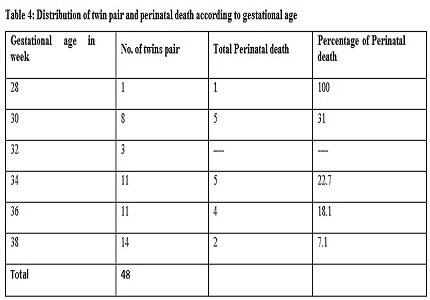Factors affecting the outcome in multiple gestations
Abstract
Introduction: Twin births are the commonest form of multiple births. Twins have attracted considerable attention and excited curiosity from early times as a biological variety in the study of the human species. Twin pregnancy is considered as high risk pregnancy. There is poor neonatal outcome in terms of mortality and morbidity.
Materials and methods: A retrospective study was conducted from Jan 2015 to Jan 2014 Mac Gann Government General Hospital. During this period there were 2643 deliveries occurred out of which 48 twins and 8 were triplets.
Results: In the present study, Incidence of twin pregnancy is 18/1000 live birth. Monozygotic twinning rate is 4.2/1000 live births, while dizygotic twinning rate is 14.2/1000 live births. Perinatal mortality in twins is 177/1000 births as compared to 74.3/1000 births in singleton pregnancy i.e., 2.38 times that of singleton pregnancy. In twin pregnancy Perinatal mortality rate in 1st twin is 62.5/1000 live births while in second twin it is 114.5/1000 births. Frequency of IUGR in twin pregnancy is 85.4%. Risk of preterm labour in twin pregnancy is 64.5%. IUGR babies are more in monochorionic than in dichorionic placenta.
Conclusion: Perinatal mortality in twin is higher than in of singleton pregnancy. Risk of single fetal loss (antepartum deaths) in twin pregnancy is higher than risk of both fetal losses. Perinatal mortality rate in 2st twin is double compared to first twin. Perinatal mortality increases as the gestational age decreases. Frequency of IUGR in twin pregnancy is very high and more in monochorionic than in dichorionic placenta.
Downloads
References
2. Gedda L Twin in the history and science. Springfield, Illinois Charles C Thomas 1961, pp52-99.
3. Rothman KJ. Fetal loss, twinning and birth weight after oral-contraceptive use. N Engl J Med. 1977 Sep 1;297(9):468-71.
4. Ghosh S, Ramanujacharyulu TK. Study of twin births in an urban community of Delhi. Indian J Med Res. 1979 Jul;70:70-7.
5. Benirschke K., Kim CK. Multiple Pregnancies. N. Engl. J. Med. 1973; 288: 1276-1329.
6. John cloherty et al Manual of neonatal care 5th edition 2004
7. Mc Carthy BJ Suchss BP et al the epidemiology of neonatal death in twins Am J Obstet Gyneco 1965;91:400-407.
8. Williams ,Obst 21st edition multiple pregnancy 767-767.
9. Rydhstroem H. Pregnancy with stillbirth of both twins. Br J Obstet Gynaecol. 1996 Jan;103(1):25-32.
10. Nkata M. Perinatal mortality in twin deliveries in a general hospital in Zambia. J Trop Pediatr. 1999 Dec;45(6):365-7.
11. Sheay W, Ananth CV, Kinzler WL. Perinatal mortality in first- and second-born twins in the United States. Obstet Gynecol. 2004 Jan;103(1):63-70.
12. Bhalla JN, Bhalla M, Srivastava JR. A study of some maternal factors associated with twinning. Indian Pediatr. 1977 Jul;14(7):539-43.
13. Williams. Multiple pregnancy. Obstetrics 17th Edition, 503-515.
14. Newton W, Keith L, Keith D. The Northwestern University multihospital twin study. IV. Duration of gestation according to fetal sex. Am J Obstet Gynecol. 1984 Jul 15;149(6):655-8.
15. Houlton MC, Marivate M, Philpott RH. The prediction of fetal growth retardation in twin pregnancy. Br J Obstet Gynaecol. 1981 Mar;88(3):264-73.
16. Ho SK, Wu PY. Perinatal factors and neonatal morbidity in twin pregnancy. Am J Obstet Gynecol. 1975 Aug 15;122(8):979-87.
17. Adam C, Allen AC, Baskett TF. Twin delivery: influence of the presentation and method of delivery on the second twin. Am J Obstet Gynecol. 1991 Jul;165(1):23-7.

Copyright (c) 2015 Author (s). Published by Siddharth Health Research and Social Welfare Society

This work is licensed under a Creative Commons Attribution 4.0 International License.


 OAI - Open Archives Initiative
OAI - Open Archives Initiative


